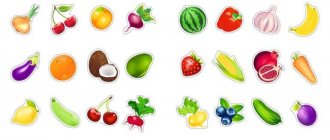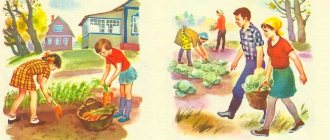Elena Pashkova
Summary of the lesson “Vegetables” in the preparatory group
1. Expanding the vocabulary on the topic: “ vegetables ”
,
2. Exercise in the use of phrases,
3. Formation of the general concept of “ vegetables ”
,
4. Development of fine motor skills, attention, memory,
5. Exercise in gender agreement between adjectives and nouns.
Pictures on the topic: “ vegetables ”
, dummies
of vegetables hedgehog
massagers , symbols: “tops”,
“roots”
, silhouettes of
“grandfather”
and a bear, real
vegetables : cabbage, cucumber, tomato, carrots, beets.
Corrective and developmental lesson on the topic “Vegetables. Garden"
Class: d/s
Presentation for the lesson
Download presentation (688.4 kB)
Goals:
- Strengthen children's knowledge about vegetables.
- Strengthen the ability to form the diminutive form of nouns.
- Strengthen children's ability to coordinate numerals with nouns.
- Develop logical thinking, attention, memory of children.
- Develop fine motor skills.
- Develop general speech skills.
- Expand your vocabulary on the topic.
Educator. Children, listen carefully to the poem.
There is a vegetable garden under the window - A lot of vegetables grow: Pumpkin, turnips and garlic, Onions, cabbage, zucchini. You can’t name everything right away - Maybe you can find more?
Educator. List the vegetables mentioned in the poem. (Children's answers). Educator. Children, look at the picture (Slide 3) and name the vegetables that you forgot to mention in the poem. (Children's answers). Educator. I'll start, and you continue. In the garden there are beds with carrots and cucumbers. (Children's answers).
Autumn has gifted you and me with a generous hand, And riddles have grown in every garden bed.
This vegetable is round in shape, yellow in color, and tastes sweet. (Pena) (Slides 4-5). This vegetable is oval-shaped, long, green, rough, crunchy, and sweet in taste. (Cucumber) (Slides 6-7). This vegetable is round in shape, yellow in color, juicy, and bitter in taste. (Bow) (Slides 8-9). This vegetable is oval-shaped, long, orange in color, juicy, crispy, and sweet in taste. (Carrot) (Slides 10-11). This vegetable is round in shape, burgundy in color, and tastes sweet. (Beets) (Slides 12-13).
Educator. (Slide 14)
On a warm sunny day, a thick zucchini lay warming itself in a garden bed. And I felt sorry for plucking it - But it can’t spend the winter in the garden.
Educator. What other vegetables can we pick from the garden? (Children’s answers: tomatoes, cucumbers, peas, eggplants) (Slides 15-16). Educator. What vegetable can we dig up? (Potatoes) (Slides 17-18). Educator. What vegetables do we pull out of the ground? (Carrots, beets, turnips, onions, radishes) (Slides 19-20). Educator. What vegetable can we cut? (Kanycmy, parsley, dill) (Slides 21-22). Educator. Let's name what actions we perform in order to collect vegetables? (Children's answers) (Slide 23). Educator. Well done! You know what you need to do to harvest. It's time to go to the garden to collect the harvest.
Physical school
(Children perform movements in accordance with the words spoken by the teacher).
We dug up potatoes, picked cucumbers from the ridge, pulled out all the carrots, and cut cabbage deftly. And they brought you a gift in a basket from the earth.
Educator.
We have a large vegetable garden, and the harvest here is good. One two three four five. We start collecting vegetables in the basket.
Educator. Look at the tomatoes (Slide 24). How are they different from each other? (Children's answers - size, small tomato, bigger, even bigger, even bigger, big tomato). Educator. We need to count the tomatoes by following the rule. And the rule is this: the larger the tomato, the louder the voice should be when counting. Look how I will do it.
(The teacher, on one exhalation, counts to 5 with a louder voice).
Educator. Now show me how you do it.
(Children perform an exercise to develop speech breathing and voice strength).
Educator. And now I will put vegetables in the basket (Slide 25). One tomato, two tomatoes, three tomatoes, four tomatoes, five tomatoes. Now put the vegetables in the basket, you children.
1st child: one cucumber, two cucumbers, three cucumbers, four cucumbers, five cucumbers. 2nd child: one turnip, two turnips, three turnips, four turnips, five turnips. 3rd child: one beet, two beets, three beets, four beets, five beets. 4th child: one carrot, two carrots, three carrots, four carrots, five carrots.
Educator. This is the harvest of vegetables we collected (Slide 26). Educator. Children, look at this drawing and tell me what vegetables are hidden here? (Slide 27). Educator. Now, children, find this drawing in your notebooks. (Children open the desired page). Children, call me affectionately:
Educator. Children, let's get our fingers ready for work.
Finger gymnastics “We have grown garlic. »
For each stressed syllable, the child kneads the phalanges of one finger, the direction of the massage movements is from the nail phalanx to the base of the finger.
We grew garlic, the index finger of the left hand. Pepper, tomato, zucchini, the middle finger of the left hand. Pumpkin, cabbage, potatoes, the ring finger of the left hand. Onions and a little peas. little finger of the left hand We collected vegetables, little finger of the right hand We treated our friends with them, ring finger of the right hand Fermented, ate, salted, middle finger of the right hand We took them home from the dacha, index finger of the right hand Goodbye for the year, thumb of the left hand Our friend is the vegetable garden! right thumb
Educator. What vegetable is the riddle about?
It is round and red, like the eye of a traffic light. There is no juicier among vegetables. (tomato)
Educator. Trace the outline of the tomato with your finger. (Children circle). Now color the tomato, not paying attention to the lines crossing its outline. (Children color the tomato). Trace the outline of the carrot with an orange pencil, and trace the outline of the cucumber with a green pencil. (Children complete tasks). In the final part of the lesson, the teacher sums it up, asking the children to briefly repeat what they did today.
types of food | Dictionary
with word definitions, example sentences and quiz
Almost everything we eat comes from plants, animals, birds, fish and other sea creatures such as shellfish . We can eat the edible parts of many plants, such as roots and leaves, as well as what plants produce, such as fruits and seeds . We can also eat various parts of animals, as well as products produced by animals, such as milk. In many parts of the world, people also eat insects and the things they produce, such as honey .
Before the development of agriculture , people obtained food from the plants and animals of the surrounding world. They dug up roots, collected fruits and seeds, hunted and captured animals and birds, and used spears and nets to catch fish. They also collected shellfish and other seafood , as well as insects and bird eggs, and in many parts of the world people still do all of this.
About ten thousand years ago, agriculture began to develop when people in the Middle East, Asia and South America began to grow plants and domesticate animals and birds. They grew grasses that produced grains such as rice and wheat, and cultivated plants that produced vegetables, nuts and beans . They also grew fruit trees and kept poultry heads for meat and eggs and raised animals for meat and milk, and about eight thousand years ago people also began producing dairy products such as cheese and yogurt from sheep's and goat's milk.
As agriculture developed, farmers began to produce more and more different types of food, and we now see a huge range of products in supermarkets. Find out more about all these types of food by visiting the pages below:
agriculture (noun): agriculture, incl. growing food crops and raising animals - If you study agriculture, you will learn about the methods and science of farming.
bean (noun): an edible seed, often bud-shaped, that grows in a long seed pod. Lima beans and coffee beans were first grown in South America.
grow (verb): to grow plants for food or other products - The British Empire grew opium poppies in India and sold opium in China.
dairy (noun): products made from milk such as butter, cheese and yogurt - Dairy products are a good source of protein.
tame (verb): to tame animals and keep them for food, work, or as pets - Animals want to be free, so taming them can be difficult.
grain (noun): seeds used for food, such as wheat, rice and millet. — Different types of bread are made from different grains.
honey (noun): a sweet and sticky food made by bees - My kids love honey on toast.
insects (noun): small six-legged animals such as bees, ants and flies - Our Thai friends love to eat deep-fried insects.
nut (noun): a hard, dry fruit with an edible seed inside a hard shell, such as a peanut or walnut - He was sitting at a bar, drinking beer and eating nuts.
poultry (noun): birds that people eat, such as chickens, ducks, geese, etc. - Most farmers keep poultry, so they don't have to buy eggs.
raise (verb): to contain and care for animals or plants, esp. for food - We raised pigs and chickens and grew our own vegetables.
root (noun): parts of a plant found underground - Did you know that potatoes and carrots are roots?
seafood (noun): anything that can be eaten from the sea - The Japanese have always eaten a lot of seafood.
seed (noun): a small, hard part of a plant that can grow into a new plant - We planted tomato seeds and within a few months we were eating our own tomatoes.
clams (noun): hard-shelled sea creatures such as crabs, shrimp, mussels and oysters - Let's start by ordering a big plate of fresh clams.
Vegetable Vocabulary Quiz by Types of Food
Posted by Matt Errey, creator of Word Up
English club: Learn English: Vocabulary: Topical vocabulary: Food: Types of food.
What vegetables are cut from the garden with a knife? What vegetables are cut from the garden?
Summary of the lesson “Vegetables” in the preparatory group
1. Expanding the vocabulary on the topic: “ vegetables ”
2. Exercise in the use of phrases,
3. Formation of the general concept of “ vegetables ”
4. Development of fine motor skills, attention, memory,
5. Exercise in gender agreement between adjectives and nouns.
Pictures on the topic: “ vegetables ”
, dummies of vegetables , hedgehog
, symbols: “tops”,
“roots”
, silhouettes of
“grandfather”
and a bear, real
vegetables : cabbage, cucumber, tomato, carrots, beets.
Dream Interpretation - Earth
Land as soil - financial situation: plowed - to good prospects, loose - to prosperity, dried - to losses; rocky - unsuccessful deal; overgrown - to a profitable investment; frozen - temporary complications in business; subject to erosion - a break with business partners will put you in a difficult situation. Cultivating the land means changes at work. Digging yourself - success will come to you through titanic work. Digging a hole - with your inflexible character you are creating trouble for yourself. Trample the ground - someone is trying to take your position through cunning and deception. Seeing the land being plowed means you will soon be offered a profitable job. Planting beds in the garden means your salary will be increased. Wearing it means honor and respect among colleagues. Water - you will become an object of intrigue and gossip from envious people. Weed - management is considering you as a candidate for dismissal.
Imagine fertilized, moist, rich, fertile soil. Throw grain at it.
Land as property - changes in family life. Buying a plot of land is a new addition to the family. Owning a plot of land will be a very profitable family business. Advertise the sale of land - constant quarrels can lead to divorce. Selling a plot of land means changing your living conditions at a loss. Donating a plot of land means improving living conditions. Receive an inheritance - receive news of the death of a relative.
Imagine that you own a huge plot of land that has no end or edge. Mentally walk through your property, admire the beauty of the landscape, inhale the aroma of flowers. Experience a feeling of peace and tranquility for your destiny and the destiny of your loved ones.
Earth as a planet - peace of mind, security. Seeing the Earth from space means you will be able to understand the current situation by looking at it from the outside. Discover new lands - be careful when choosing new friends. To see the long-awaited land from a ship - you will receive wise advice and support. Desert island - you are burdened by loneliness.
Remember that part of the planet that struck you with special beauty, no matter whether you saw it in a picture, on TV, or with your own eyes. Try to examine the details in great detail and enjoy the charm of the world around you.
Potato
It is customary to dig up potato tubers in the last days of August. By this time, the skin covering them should become rough.
This is an important condition for good storage quality of the crop. In this condition, the potatoes will be perfectly stored throughout the winter.
If rainy and cold weather sets in before the due harvest date, there is a risk of tubers rotting in the ground. In this case, you cannot hesitate. When the first sunny days arrive, it is necessary to start digging up potatoes that have not had time to ripen.
This is done as carefully as possible so as not to damage the thin skin. Do not scrape off wet soil from the tubers. They are left to dry in the fresh air under a canopy for 2 hours. The crop cannot be dried longer. Potatoes can turn green and spoil due to the solanine formed in them.
Upon completion of drying, carefully remove the soil from each tuber with your hands. The harvest is left in a cool and dark room. It should be dry there. The potatoes are left to rest for 2-3 weeks. During this time, it will finally dry out and ripen.
Brussels sprouts
Oddly enough, heads of Brussels sprouts can also be left in the beds until the first snow - after exposure to cold they will only become tastier, without losing any vitamins and nutrients. You can consider the cabbage to be “in the refrigerator” and harvest as needed.
However, this is good - after all, this crop is extremely “slow” - almost six months pass from spring sowing to maturity; heads of cabbage begin to set only with the decline in the summer heat.
3-3.5 weeks before harvesting the cabbage, trim the top and remove all the leaves so that energy can be used to ripen the fruit. Wait until the thermometer drops below –6°C, but does not reach –10°C – at this time the heads of cabbage are most suitable for harvesting for storage. Remove them gradually, starting from the lower ones, leaving the upper ones the opportunity to “reach”.
Store Brussels sprouts buried in boxes with soil (for such storage, cabbage is dug up with roots) or dried simply on the shelves of the cellar (this is how stems with heads are stored, cutting off the top, all leaves and roots).
- Brussels sprouts: sowing, growing and care
Want to grow Brussels sprouts but don't know where to start? We will tell you everything about caring for this useful and unusual vegetable.
Apples
To increase the keeping quality of summer and spring varieties of apples, they are plucked from the branches without waiting for ripeness to occur. Winter varieties simply do not have enough time to ripen on the tree.
Unripe fruits are easy to ripen. The duration of this process is determined by the variety of apples. When ripening, the crop acquires the desired taste characteristics.
To bring fruits removed from the branches ahead of schedule to ripeness, they are left in a warm room at a temperature of +20°C.
If it is necessary for the crop to ripen slowly, the temperature regime is reduced.
Dream Interpretation - Earth
“go underground” hide, hide.
“to be closer to the earth” stability, solidity, balance. “May you rest in peace” peaceful death. “Falling through the ground” is a curse, guilt, shame.
“favorable soil” luck. “Wipe from the face of the earth” to destroy.
“to knock the ground out from under someone’s feet” to deprive someone of their position or confidence. “Burying talent in the ground” is ruining, not using abilities, putting things off. “Test the waters” to get your bearings, to find out the situation. “To dig the ground (with your nose)” to actively act, to try your best. “The earth is disappearing from under your feet” is a strong emotional experience.
“the earth cannot bear him” about a very bad person. “To lose (or feel) the ground under your feet” to gain confidence or lose life goals and guidelines. “To fall or fall on fertile ground” is success, the flowering of one’s abilities.
Harvesting carrots
Dig carrots on a dry, cloudy, cool day. Since the root crops are long (15-20 cm), there is no need to pull them out of the ground by the tops; they often break. To dig carrots, the soil is lightly raked from its tops, then dug with a shovel, lifting the carrots and removing them from the ground. Long root vegetables are dug up to the fullest extent, otherwise they will break off.
Do not dig up carrots with a pitchfork, since it is easy to pierce the root vegetables, then they will not be stored. Root cuts heal quickly, but punctures do not heal for a long time. When digging, an infection often gets into the puncture and the root crop rots. During storage, the tissue around the puncture becomes woody and rough, the vegetable itself loses a significant amount of sugars and becomes tasteless.
Short-fruited varieties (for example, Karotel) are pulled out by the tops; their root crops are short, round and do not break during harvesting. However, in the case of very dense soil, even these varieties have to be dug up.
The dug carrots are placed along the edge of the bed, and after harvesting is completed, they immediately begin to process the crop.
Preparing the harvest for storage
Preparation of the crop for storage is carried out within 1-2 days. When the process is delayed, root vegetables lose a large amount of moisture, become flabby, the process of destruction of sugars occurs and the vegetables become tasteless. Preparation for storage consists of:
- removal of tops;
- washing root vegetables;
- top trimmings;
- crop sorting;
- drying.
Removing tops . Immediately after digging up the carrots, all tops are removed. The leaves evaporate water very strongly, and if they are not trimmed in time, the root crops wither. The tops can be twisted or cut with a knife
Washing . After removing the tops, the root vegetables are washed. You can add potassium permanganate to a container of water until it turns slightly pink. The solution disinfects vegetables, and they are stored much better. You don’t have to wash the crop, it doesn’t affect the keeping quality in any way. Washing is more of an aesthetic characteristic: washed carrots are more pleasant to pick up than dirty ones with lumps of earth.
Collection rules
In addition to taking into account the growing season and the number of approaches for each crop, there are certain nuances of collection. The quality of vegetables is affected by harvest time and weather conditions.
Most fruit crops harvested in wet weather quickly spoil
General recommendations:
- In clear weather, long-lasting root crops are cut and dug up. A wet product spoils faster than a dry one.
- Vegetables that go to the cellar are collected at the stage of technical maturity. This extends the storage period.
- Crops harvested on a rainy day have fewer beneficial elements, especially potassium.
- Legumes should be harvested after rain or in the morning, when the dew has not yet disappeared. Otherwise, the fruits will crumble.
- It is advisable to do the planned collection of vegetables early in the morning. During the day in the sun, they lose their taste.
By following these instructions, you can enjoy fresh produce throughout the cold season.
It is advisable to cut vegetables for jams at the stage of biological maturity
Pumpkin
The pumpkin may not have time to ripen before frost. If the crop is not harvested in a timely manner, it will freeze as the outside temperature drops and will not be able to be stored for a long time. Some varieties of pumpkin simply do not have time to fully ripen during the summer.
Unripe fruits can be successfully ripened at home at room temperature. However, pumpkins ripened in the garden last longer than those ripened at home.
In order for the pumpkin to ripen at home, it is removed from the garden on a warm, dry day. This should be done before frost. Damaged and frozen fruits are not stored for a long time; for this reason, the crop is harvested and transported carefully.
Separate the pumpkin from the vine with a knife so as not to damage the flesh. In this case, leave a stalk at least 5 cm long.
The harvested crop is cleared of soil, sorted, dried and sent to a warm place for ripening. The pumpkin will ripen from several weeks to 2 months.
Conditions up to +20°C are considered comfortable for storage.
Horseradish
The time to think about harvesting horseradish from the beds comes around the very end of October-beginning of November. This crop will feel great in the garden until the frosts - it will even accumulate more nutrients, become aromatic, sweetish and not so vigorous.
Horseradish is harvested after its foliage has completely turned yellow and withered. Dig up the root crops with a fork or pry them with a spatula to a depth of 40 cm, then pull them out of the soil and dry them before storing them.
However, it is not necessary to do this either - you can leave the horseradish in the garden until spring. To do this, after cutting the tops, you simply need to cover the plants with a thick layer of mulch (peat, straw, etc.). Horseradish can grow in one place for about five years.
- Growing horseradish: which one to choose, when to plant, how to limit
Are you having trouble growing horseradish on your property? We are ready to share with you the secrets of growing this crop.
Dream Interpretation - Earth
Plowed land means wealth.
Land overgrown with weeds means poverty.
The ground thawed after frost is good luck.
Abandoned land means losses and troubles.
Walking on the ground and checking its looseness - the upcoming new business can be very risky.
Plowing the land in a dream, or plowing yourself is a sign that you will soon be offered a profitable job, promoted or increased in salary.
Cultivate the land - to success in business, profit and material well-being.
The soil has been eaten away by erosion - you can expect conflicts in the family, quarrels over trifles.
Your own plot of land - an interesting job awaits you, which will bring you both moral satisfaction and material profit.
Someone else's plot of land - an unsuccessful or ill-considered waste of money awaits you. Such a dream may also mean your inaction, unwillingness to make additional efforts to achieve your goal.







